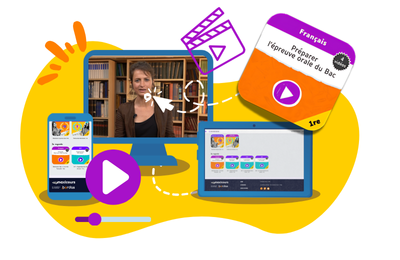What is Art for ?
- Fiche de cours
- Quiz et exercices
- Vidéos et podcasts
- Découvrir un des aspects de la notion d'étude art et pouvoir
- Approfondir sa réflexion sur la question du sens de l'art
L'art est une question personnelle, mais si nous nous y intéressons tous, c'est bien qu'il répond à des besoins, pas uniquement esthétiques, que nous avons tous. Lesquels ?
- L'art agit comme un antidépresseur en nous permettant d'oublier nos problèmes.
- L'effet inverse est aussi vrai : il nous réconforte en nous montrant que nous ne sommes pas les seuls à vivre des moments durs.
- L'art peut nous compléter en nous apportant ce qu'il nous manque.
- L'art révèle que la beauté est partout.
- Les images étant souvent plus explicites que les mots, l'art se fait le support de messages (politiques, optimistes, de dénonciation...)
It seems very difficult to answer this simple question because art is a personal matter and everybody has their own opinion about it. But the fact that lots and lots of people go to museums everywhere in the world shows that we need art not only because what we are going to see is beautiful but also because it brings us something we are looking for in our lives as we are going to see below.
Five reasons will show you that the importance of art does not only lie in the aesthetic characteristics of the subject painted, though it is one of the reasons why people will admire a painting. Indeed art matters more than we think because it helps us tackle with life and its issues in a different way.
First, art makes us positive, optimistic, hopeful. Flowers, happy people or blue skies contrast with our everyday lives and while we are watching them we do not think of the terrible catastrophes that surround us (wars, earthquakes, pandemics...). They act on us like a cure and prevent us from falling into depression.
Then, we must keep in mind that other types of paintings like those depicting sadness or pain may reassure us in the sense that they tell us that life is not a long, quiet river. Edvard Munch’s Melancholy is evidence that loneliness and distress exist and that lots of people have to put up with them, just like us. We are not alone in facing problems in our day-to-day business.
Art is also a compensation for what we are not or what we lack like tenderness or optimism for example. Art is consequently meant to counterbalance all those who are too emotional, too artistic or too intellectual and who feel that something is missing in them. We love to see what we are not familiar with because we are always looking for it. Being more balanced is also being saner.
Art makes us understand that insignificant things can be glamorous, as glamorous as models or cars that media love to praise. Grass, skies can be glamorous too. Have a look at Turner’s skies to understand that glamour can hide where you do not expect it. Remember Van Gogh’s Still Life with Baskets and Six Oranges or Marcel Duchamp’s urinal called Fountain. Art is thus giving a central role to things that really matter and does not focus on superfluous subjects.
Last, we all have seen on different occasions that art can be used for propaganda because images are often more explicit than words, but works of art do not only promote political views like Picasso’s Guernica which denounces war, they can also highlight more optimistic subjects like landscapes or a happy family and express that life can be worth living too.
To sum up we can say that there is more to art than aesthetic lines and shapes. It is a source of support that offers a more peaceful approach to life. Art encompasses lots of positive values which we must learn to decipher when admiring a work of art. It is not beautiful only; it tries to tell us things that we must be prepared to catch. Art reveals what is in our hearts.

Des quiz et exercices pour mieux assimiler sa leçon
La plateforme de soutien scolaire en ligne myMaxicours propose des quiz et exercices en accompagnement de chaque fiche de cours. Les exercices permettent de vérifier si la leçon est bien comprise ou s’il reste encore des notions à revoir.

Des exercices variés pour ne pas s’ennuyer
Les exercices se déclinent sous toutes leurs formes sur myMaxicours ! Selon la matière et la classe étudiées, retrouvez des dictées, des mots à relier ou encore des phrases à compléter, mais aussi des textes à trous et bien d’autres formats !
Dans les classes de primaire, l’accent est mis sur des exercices illustrés très ludiques pour motiver les plus jeunes.

Des quiz pour une évaluation en direct
Les quiz et exercices permettent d’avoir un retour immédiat sur la bonne compréhension du cours. Une fois toutes les réponses communiquées, le résultat s’affiche à l’écran et permet à l’élève de se situer immédiatement.
myMaxicours offre des solutions efficaces de révision grâce aux fiches de cours et aux exercices associés. L’élève se rassure pour le prochain examen en testant ses connaissances au préalable.

Des vidéos et des podcasts pour apprendre différemment
Certains élèves ont une mémoire visuelle quand d’autres ont plutôt une mémoire auditive. myMaxicours s’adapte à tous les enfants et adolescents pour leur proposer un apprentissage serein et efficace.
Découvrez de nombreuses vidéos et podcasts en complément des fiches de cours et des exercices pour une année scolaire au top !

Des podcasts pour les révisions
La plateforme de soutien scolaire en ligne myMaxicours propose des podcasts de révision pour toutes les classes à examen : troisième, première et terminale.
Les ados peuvent écouter les différents cours afin de mieux les mémoriser en préparation de leurs examens. Des fiches de cours de différentes matières sont disponibles en podcasts ainsi qu’une préparation au grand oral avec de nombreux conseils pratiques.

Des vidéos de cours pour comprendre en image
Des vidéos de cours illustrent les notions principales à retenir et complètent les fiches de cours. De quoi réviser sa prochaine évaluation ou son prochain examen en toute confiance !









